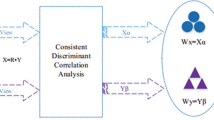Abstract
This paper proposes a novel multi-view discriminant analysis based on Hilbert-Schmidt Independence Criterion (HSIC) and canonical correlation analysis (CCA). We use HSIC to identify a lower dimensional discriminant common subspace in which the dependence between multi-view features and the associated labels is maximized. CCA is utilized to achieve maximum correlation between different views in the common subspace. Motivated by the successful application of uncorrelated discriminant analysis, we further extend our approach to extract features with minimum redundancy. Experimental results validate the effectiveness of our proposed approaches.


Similar content being viewed by others
References
Amini M, Usunier N, Goutte C (2009) Learning from multiple partially observed views-an application to multilingual text categorization. In: Advances in neural information processing systems, pp 28–36
Cai D, He X, Han J, Zhang HJ (2006) Orthogonal laplacianfaces for face recognition. IEEE Trans Image Process 15(11):3608–3614
Dhillon P, Foster DP, Ungar LH (2011) Multi-view learning of word embeddings via cca. In: Advances in neural information processing systems, pp 199–207
Diethe T, Hardoon DR, Shawe-Taylor J (2008) Multiview fisher discriminant analysis. In: NIPS workshop on learning from multiple sources
Gretton A, Bousquet O, Smola A, Schölkopf B (2005) Measuring statistical dependence with Hilbert-Schmidt norms. In: Algorithmic learning theory. Springer, pp 63–77
Gross R, Matthews I, Cohn J, Kanade T, Baker S (2010) Multi-pie. Image Vision Comput 28(5):807–813
Han Y, Wu F, Tao D, Shao J, Zhuang Y, Jiang J (2012) Sparse unsupervised dimensionality reduction for multiple view data. IEEE Trans Circuits Syst Video Technol 22(10):1485–1496
Hardoon DR, Szedmak S, Shawe-Taylor J (2004) Canonical correlation analysis: an overview with application to learning methods. Neural Comput 16(12):2639–2664
Hu P, Peng D, Guo J, Zhen L (2018) Local feature based multi-view discriminant analysis. Knowl-Based Syst 149:34–46
Kan M, Shan S, Zhang H, Lao S, Chen X (2012) Multi-view discriminant analysis. In: ECCV 2012. Springer, pp 808–821
Lampert CH, Krömer O (2010) Weakly-paired maximum covariance analysis for multimodal dimensionality reduction and transfer learning. In: Computer vision–ECCV 2010. Springer, pp 566–579
Peng Y, Lu BL (2017) Discriminative extreme learning machine with supervised sparsity preserving for image classification. Neurocomputing 261:242–252
Rasiwasia N, Costa Pereira J, Coviello E, Doyle G, Lanckriet GR, Levy R, Vasconcelos N (2010) A new approach to cross-modal multimedia retrieval. In: Proceedings of the international conference on multimedia. ACM, pp 251–260
Rupnik J, Shawe-Taylor J (2010) Multi-view canonical correlation analysis. In: Conference on data mining and data warehouses (siKDD 2010), pp 1–4
Sharma A, Kumar A, Daume H, Jacobs DW (2012) Generalized multiview analysis: a discriminative latent space. In: IEEE conference on computer vision and pattern recognition (CVPR). IEEE, pp 2160–2167
Sigal L, Memisevic R, Fleet DJ (2009) Shared kernel information embedding for discriminative inference. In: IEEE conference on computer vision and pattern recognition. IEEE, pp 2852–2859
Sun QS, Zeng SG, Liu Y, Heng PA, Xia DS (2005) A new method of feature fusion and its application in image recognition. Pattern Recogn 38(12):2437–2448
Sun S, Xie X, Yang M (2015) Multiview uncorrelated discriminant analysis. IEEE Trans Cybern PP(99):1–13
Sun T, Chen S (2007) Locality preserving cca with applications to data visualization and pose estimation. Image Vis Comput 25(5):531–543
White M, Zhang X, Schuurmans D, Yu Yl (2012) Convex multi-view subspace learning. In: Advances in neural information processing systems, pp 1673–1681
Yang Y, Zhang W, Xie Y (2015) Image automatic annotation via multi-view deep representation. J Vis Commun Image Represent 33:368–377
Ye J, Janardan R, Li Q, Park H (2006) Feature reduction via generalized uncorrelated linear discriminant analysis. IEEE Trans Knowl Data Eng 18(10):1312–1322
Zhang Y, Zhou ZH (2010) Multilabel dimensionality reduction via dependence maximization. ACM Transactions on Knowledge Discovery from Data (TKDD) 4(3):14–34
Zhao G, Pietikainen M (2007) Dynamic texture recognition using local binary patterns with an application to facial expressions. IEEE Trans Pattern Anal Mach Intell 29(6):915–928
Acknowledgements
This work was supported by the Natural Science Foundation of China (Grants NO.61602248), the Natural Science Foundation of Jiangsu Province (Grants No. BK20160741) and the Fundamental Research Funds for the Central Universities (No.KJQN201733).
Author information
Authors and Affiliations
Corresponding author
Rights and permissions
About this article
Cite this article
Shu, X., Yuan, P., Jiang, H. et al. Multi-view uncorrelated discriminant analysis via dependence maximization. Appl Intell 49, 650–660 (2019). https://doi.org/10.1007/s10489-018-1271-6
Published:
Issue Date:
DOI: https://doi.org/10.1007/s10489-018-1271-6




